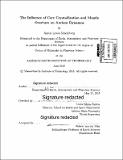The influence of core crystallization and mantle overturn on ancient dynamos
Author(s)
Scheinberg, Aaron Lewis
DownloadFull printable version (12.64Mb)
Other Contributors
Massachusetts Institute of Technology. Department of Earth, Atmospheric, and Planetary Sciences.
Advisor
Linda Elkins-Tanton.
Terms of use
Metadata
Show full item recordAbstract
This dissertation contributes to three unresolved problems in planetary science regarding potential dynamo action in asteroids, the Moon, and Mars. First, we examine the physical processes active during asteroid core crystallization. We model inward crystallization as well as crystal settling and the compaction of a possible cumulate inner core. We then explore the potential strength and longevity of a dynamo in the planetesimal's early history. We find that cumulate inner core solidification would be capable of sustaining a dynamo during the bulk of solidification, but that there may be insufficient power for a dynamo in an inward dendritic solidification scenario. Next, we explore the origin of the magnetic field recorded in the lunar crust. Evidence suggests a core dynamo existed from 4.2 to 3.56 Ga, and possibly until near present day. Seismic measurements indicate the lunar core is partially solidified. Latent heat and concentrated light elements at the interface of a solidifying inner core could drive outer core convection. We demonstrate that core solidification can account for the observationally inferred duration of the lunar dynamo. However, it cannot explain the magnitude of the recorded magnetic field. A dynamo may also stop and restart due to heat flow fluctuations as convective vigor falls below the threshold for dynamo action. Finally, we examine the early history of the Martian mantle. The solidification of a magma ocean may result in an unstable density profile prone to overturn. A long-wavelength instability could play a role in the stark contrasts observed between the northern and southern hemispheres of Mars, including the dichotomy in crustal thickness and magnetization. However, we find that cumulate overturn in the Martian scenario would likely have occurred with short wavelengths. In an isoviscous model, thermal convection ensues rapidly after overturn; however, when viscosity is temperature dependent, compositional stability suppresses the onset of convection.
Description
Thesis: Ph. D., Massachusetts Institute of Technology, Department of Earth, Atmospheric, and Planetary Sciences, 2015. Cataloged from PDF version of thesis. Includes bibliographical references (pages 119-135).
Date issued
2015Department
Massachusetts Institute of Technology. Department of Earth, Atmospheric, and Planetary SciencesPublisher
Massachusetts Institute of Technology
Keywords
Earth, Atmospheric, and Planetary Sciences.